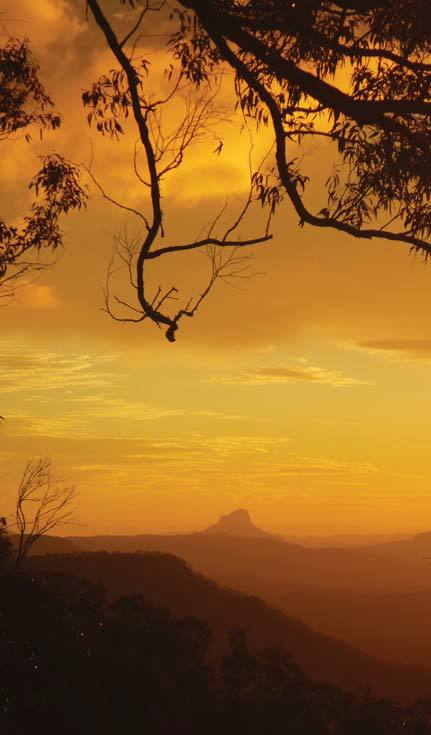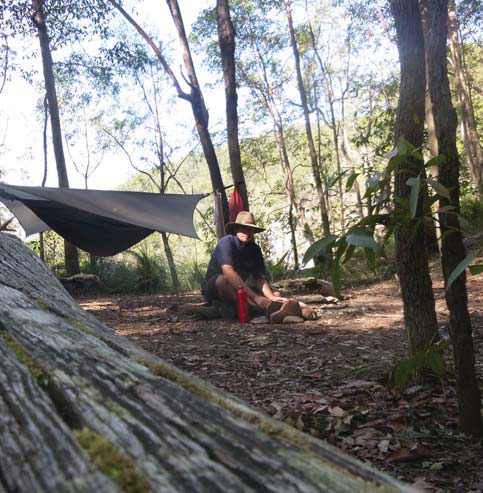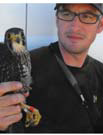Header: A magnificent Red Goshawk in flight. Photo by James Watson.
Above: The author camping during his Red Goshawk surveys.

With its enormous taloned feet, rufous- striped body, powerful hooked bill and crested head, the Red Goshawk is nothing short of spectacular. Although this bird of prey has never been considered a common species, it once bred throughout the tall eucalypt forests that stretch from southern New South Wales up to Cape York and across the Top End. Today, however it is thought to be Australia’s rarest bird of prey.
I first heard of the Red Goshawk over 15 years ago, when a colleague returned to New Zealand from a trip to tropical Queensland. In a hushed voice he leaned across the restaurant table and with wide eyes told me he had seen a Red Goshawk. A seed was sown.
Requiring large tracts of biodiverse habitat, the Red Goshawk naturally occurs at low densities. As a result, it is well known amongst the birdwatching community as a very difficult bird to find and it seems no wonder that sightings of this species in SEQ are few and far between. On the other hand experts were concerned that the number of reports from the public had begun to decline and a renewed effort was required to establish how Red Goshawks are faring in SEQ.
With the support of SEQ Catchments, Griffith University, The Queensland Department of Environment & Heritage Protection, Birds Queensland and BirdLife Southern Queensland, I packed up my hammock, billy and binoculars ready to head out into the bush. But before I set o I needed to speak with those who had gone before me, local Red Goshawk experts Greg Czechura, Rod Hobson and David Stewart. As they regaled me with stories of their adventures searching for this enigmatic bird three things became apparent – searching for this bird was going to be hard work, I would need to get out into the less populated parts of SEQ and it would require a great deal of patience on my part. Overall, one thing was clear – this was not going to be easy!
Starting in December 2013 I bush camped for the next four months, spending dawn until dusk searching for Red Goshawks from high points and along valley bottoms. The breeding season (Dec-May) was considered the most conducive to maximising observations as both adults and edglings are active during this period. Particular focus was given to areas where breeding activity had been recorded in the past 20 years.
My weeks typically involved hiking into the bush early Monday morning, bush bashing around until I found a good vantage point, camping for the night at that spot and then moving onto another vantage point the next day, until I finally came out of the bush on a Friday evening to head home and restock supplies. Being a relatively recent arrival from overseas I have to admit to the Aussie bush being a rather intimidating experience for me. If it wasn’t snakes frightening me half to death, cicadas making my ears ring or ticks and leaches making me bleed, the heat and humidity were doing their best to desiccate my delicate winter white skin! Mind you, camping in places like the Lost World Plateau in Lamington, high on the ridge in Main Range National Park and by the pools at Summer Falls in the Conondales more than made up for these trying work conditions. Every location proved to be as spectacular as the last.
After five months I had spent a total of 470 hours of active searching in the bush around SEQ. But all in vain, as sadly I was unsuccessful in locating a single Red Goshawk. Several raptor nests were observed, but only one inactive nest appeared to have the potential to be a Red Goshawk nest. Further investigations are required to verify the species using this nest. All other species of raptor, except the rare arid-zone Grey Falcon, were seen during this survey.

So what does this mean? Well, it is certainly not looking good for Red Goshawks in SEQ. Similar surveys to the one I conducted were undertaken in 2001 during which Red Goshawks were encountered on six occasions. Experts think that these results tell us that the distribution range of this magnificent bird is shrinking towards the north. This theory is consistent with recent suggestions by raptor experts that the Red Goshawk has become extinct from NSW. Most distressing, this finding has implications for environmental health, with the loss of this species that sits at the top of the food chain suggesting a more widespread decline in biodiversity in SEQ. But can we be sure Red Goshawks have gone from SEQ? Well, it is hard to definitively know and that is where we need your help.

As the Red Goshawk is a very difficult bird to find the only way we can be certain whether it has disappeared from SEQ, or is still present, is for lots of people to keep looking. Red Goshawks look similar to a number of other birds of prey, namely Square-tailed Kites and Little Eagles, and these species are often mistaken for a Red Goshawk. However, if you think you have seen a Red Goshawk, even better if you have a photo (even a distant photo), then we would love to hear from you. Please contact Liz Gould at SEQ Catchments – [email protected]
Losing Red Goshawks from SEQ would be one thing, but losing them without anyone noticing and not learning from the loss of this species would be a tragedy. It is important that we learn what is limiting the survival of Red Goshawks in SEQ so that we can address these issues elsewhere in its range and work towards restoring the landscape in SEQ to once again support what has to be one of Australia’s most magnificent birds.
The full survey report can be viewed online via the SEQ Catchments website > Resources page.
Article by Dr Richard Seaton

My chickens where just attacked by a red/ brown hawk it flew into the cage with a bang I went out side and it flew off with a few others maybe 5/6 Currumbin Goldcoast Queensland